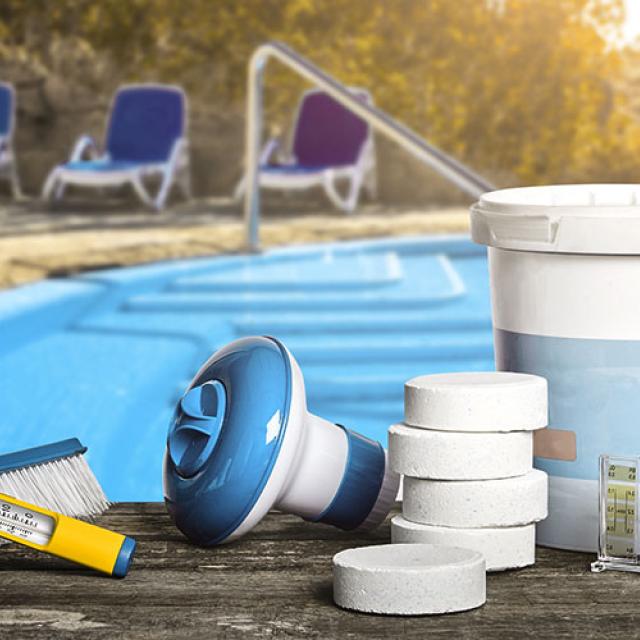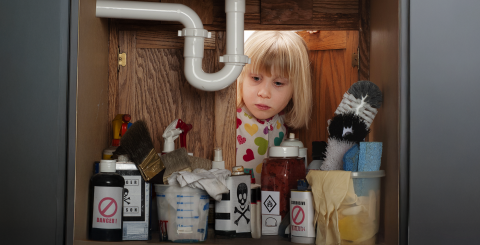Everything you need to know about pool and hot tub maintenance

Do you own (or want) a pool or hot tub? You’re probably already well aware that maintenance is crucial if you want to enjoy these costly assets for years to come. To make sure you can, we’ve compiled these answers to all your pool and hot tub maintenance questions.
A few facts about pools
Quebecers like to make the most of summer, so many install pools in their backyards. Here are some fun facts about pools in Québec:
On average, how many pools are sold each year?
Did you know that there are more pools per capita in Québec than in California and as many as in Florida? It’s obvious that Quebecers really like having their own pools at home. Every year, about 30,000 pools are sold across the province. Roughly one out of every two new pools sold in Canada is installed in Québec. Most people buy their pools in June, which makes for a very busy month. You may get a deal if you shop for a pool off season since many dealers offer discounts to clear inventory once summer ends.
What are the main differences between aboveground and inground pools?
There are about 500,000 residential pools in Québec, most of them above ground. Not sure about whether to buy an aboveground or inground pool? Consider the pros and cons of each type.
Aboveground pools: By some estimates there are about 400,000 aboveground pools in Québec.
- Pros:
- Cost – An aboveground pool costs between $3,000 and $12,000 on average to install. This is about five times less expensive than for an inground pool.
- Space requirements – Aboveground pools generally take up less space than inground pools.
- Maintenance – Aboveground pools usually need fewer water treatment chemicals.
- Water and electricity – Aboveground pools usually need less of both.
- Installation time and ease of removal – Aboveground pools are faster to install than inground models. It’s also easy to take them down.
- Cons:
- Size limit – Aboveground pools are usually smaller than inground ones.
- Few choices of shape – You can only have round or oval pools.
- Depth is standardized and uniform.
- They don’t last as long.
- They barely affect your property value.
Inground pools: There are about 100,000 inground pools in Québec.
- Pros:
- Customization – Inground pools boast a much wider range of sizes, shapes, materials, and landscaping options.
- Larger area – There’s more room to swim, and the depth varies.
- Æsthetic appeal – They look much better and allow for more attractive landscaping.
- Durability – They withstand winter and water temperature fluctuations better.
- Value – They increase your property’s resale value.
- Multipurpose – They can be for relaxing, exercising, or keeping children entertained (slides, etc.).
- Cons:
- High cost – An inground pool costs between $20,000 and $45,000 on average.
- Installation time – Building the pool takes more time due to excavation and to landscaping issues like paving.
- Maintenance – Inground pools usually need more maintenance, products, and accessories.
- The water warms up more slowly.
Maintaining a pool
What items do you need to maintain a pool?
To maintain a pool so it lasts, you need the right equipment. When it’s time to shop for pool equipment, bring this list of maintenance items with you:
Cleaning:
- Surface skimmer
- Pool sweeper or vacuum cleaner (flexible hose, telescoping handle, and broom head)
- Drain hoses
- Robot (automated version of sweeper/vacuum cleaner)
- Wall brush
- Cleaning products (for the filter, edges, metal, stains, etc.)
Water purification:
- Filtration pump
- Skimmers
- Pool bottom drain
- Filter (sand, cartridge, diatomaceous earth, glass, or zeolite)
- Inlet jets
- pH and chlorine test kit
- Chlorine or salt
For problems with pool water:
- pH stabilizer
- Calcium scale sequestering agent
- Algaecide
- Pool water clarifier for clear water
What maintenance does a pool require?
There’s more to maintaining a pool than stabilizing the water and clearing leaves and debris during summer. Here’s what you need to do in each season to maintain a pool:
- Summer:
- Clean your pool using a sweeper or a manual or automatic vacuum cleaner at least once a week.
- Brush the pool sides and bottom regularly to remove calcium and organic matter deposits.
- Check pH levels to balance the water. To balance pH, use pH+ or pH- products as needed, and not chlorine. If you use a saltwater system, regularly clean the electrodes of your saltwater chlorinator i.e., every six months.
- Fall:
- Install a net or cover to facilitate pool maintenance during the fall.
- Properly shut down and prepare your pool for winter.
- Winter:
- Keep the pool cover clean and check its fit.
- To keep your aboveground pool from collapsing, regularly clear snow from around the edge. However, don’t clear snow from the sides since it provides natural insulation.
- Ensure the power stays off.
- Spring:
- Inspect your pool and equipment for possible defects.
- Monitor the water level as the snow melts and drain as required.
- Follow the procedure below to open your pool.
- When the temperature reaches 15–20 degrees, you can add more winter algaecide or granular chlorine to prevent algae growth.
Opening your pool in spring
After a long winter, it’s finally time to open your pool for summer. First of all, the sooner you open it the better. That will prevent algal growth. Once the ice has melted, follow these steps to properly prepare your pool for summer:
1. Leaves
Start by removing the pool lid or winter cover and clearing leaves using the surface skimmer. Remember to clean and dry your cover before you store it.
2. Cleaning the edges
Use a suitable cleaning product and brush to clean the ring around the pool’s rim.
3. Restarting the pool equipment
If you have an inground pool, remove the caps from the inlet jets and skimmer. Raise the water level above the skimmer. Next, reconnect the filter and pump, as well as all other components that were turned off in the fall. If you have an aboveground pool, reinstall the backwash hose, pressure gauge and filter bubble and put the tank cap back on.
4. Gentle backwash
Perform a gentle backwash following the pool manufacturer’s instructions.
5. First vacuuming
The first time you vacuum the pool, use the DRAIN or WASTE function to take the dirty water out of the pool.
6. Water test and treatment
After letting the water circulate in the pool for six hours, test the water using a pool water test kit. Use the appropriate pool shock treatment depending on the result.
7. Second backwash
Wait 24 hours, then perform a second backwash. Run the pump continuously until the water is clear.
8. Second water test
Test the water again. Adjust water alkalinity and hardness as needed using suitable products. Stabilize and treat the water using a pool water stabilizer.
9. One last backwash
Once you’ve opened your pool, backwash the filter and clean it thoroughly.
10. Test often until water is stable.
All that’s left to do is to frequently test the water until it’s stable. When the water is stable, it’s time to jump in!
How do you close your pool in the fall?
After enjoying your pool all summer, you need to make sure it is properly closed to withstand the harsh Québec winter. Don’t close it too early—wait until the end of autumn, just before the first frost. This is how you close a pool:
1. Clean the pool thoroughly
Start by completely cleaning the pool and the water. Backwash the pool. Remove and store all pool accessories. Clean the solar cover using a degreaser, then dry and store it.
2. Empty the pool
Lower the water level to 30 to 45 centimetres below the skimmer. Pour pool closure kit in the water to maintain its chemical balance.
3. Store components
Empty the pump, hoses, and water filter and store them dry. Unscrew the pressure gauge and the bubble filter and store them in a dry place. Remove the tank cap and set the filter to the WINTERIZE or WINTER position.
4. Use antifreeze
Remove the skimmer door and basket and pour in one or two gallons of antifreeze. Protect the skimmer from ice expansion by inserting insulation foam in its ducts. Put pieces of Styrofoam in the skimmer. Put the lid back on and wrap the skimmer in a plastic bag.
5. Install a winter cover
Tightly install your winter cover. Secure the edges so it withstands heavy snow and bad weather.
What do you do when your pool water is green?
You need to thoroughly test the water and use suitable products based on test results. Home kits are available, but if the problem persists, take a clean bottle and fill it with pool water by submerging it 30 centimetres underwater, then bring it to a specialist for analysis. They can suggest the right shock treatment. Professional testing is usually done free of charge.
How much does it cost for all the equipment needed to maintain a pool?
Plan to spend about $200 on average for pool cleaning equipment and products. Budget about $2,000 to buy all the equipment you need to maintain and protect your pool (vacuum cleaner, surface skimmer, brush, solar cover, winter cover, etc.).
What are the ideal pH and alkalinity levels of a pool?
A pool’s ideal pH is between 7.2 and 7.6. Water alkalinity should be between 80 and 120, or even 140 parts per million, based on the treatment used.
How to maintain a hot tub
What items do you need to maintain a hot tub?
To get the most out of your hot tub for as long as possible, you need to take good care of it. Here’s the equipment you’ll need:
- Vacuum
- Filter
- Chemical feeders
- Scale preventative
- Spa sanitizer (chlorine, bromine, or lithium hypochlorite)
- Water chemical balancers
- Shock treatments
- Clarifier
- Anti-foam
- Cleaning brush
- Surface skimmer
- Drain cleaner
What maintenance does a hot tub require?
- Test the water two to three times each week. Adjust pH, alkalinity, calcium hardness, and disinfectant levels as needed.
- Clean the filter every month using a suitable product. Let it dry, then reinstall it.
- Every three or four months drain the hot tub and clean all surfaces, water lines, and plumbing using suitable cleaners.
- Regularly vacuum the benches and floor.
- Frequently remove floating debris using a surface skimmer.
- Air out the cover two or three times a week.
- Check and adjust the water level so it’s always at the skimmer’s midpoint.
What’s the procedure for opening a hot tub in the spring?
Many Quebecers use their hot tub year round, but if you don’t use it in the winter, here’s how to reopen it in springtime:
- 1. Ensure the hot tub’s base is level.
- 2. Remove the protective winter cover and the lid. Clean the lid using a suitable cleaner. Rinse it thoroughly.
- 3. Connect components like motors, the ozone generator, and the blower.
- 4. Thoroughly clean inside the tub and the filters.
- 5. Refill the tub and the pumps (if the tub was drained completely).
- 6. Start all the pumps and pour in drain cleaner.
- 7. Empty the tub using the drain valve or a pump. Rinse the inside again with plenty of water and drain excess water.
- 8. Fill your tub with fresh water. Start the pumps and replace the cover. Adjust the temperature.
- 9. To balance the water, adjust alkalinity to 100 ppm and balance the pH. Replace the cover.
What’s the procedure for closing a hot tub in the fall?
If you don’t want to use your hot tub in winter, you have two options: drain the tub completely or keep water in it.
To drain it completely for the winter:
- 1. Turn off the power and completely empty the tub by opening the drain valve or using a pump.
- 2. Empty stagnant water from the pumps and pipes using a blower.
- 3. Once the tub is completely drained, pour antifreeze in the skimmer and wrap the pipes with insulation.
- 4. Cover the tub with an insulated cover as well as your regular cover.
To keep water in it for the winter:
- 1. Completely drain the tub.
- 2. Carefully clean the tub’s filters and inside and remove all calcium from the plumbing.
- 3. Fill the tub halfway.
- 4. Make sure the pH is right and the temperature is between 95°F and 100°F.
- 5. Treat the water all winter long. Remember to use bromine or chlorine tablets.
- 6. Let the water temperature drop to 60°F. You need to keep the water at this temperature throughout the winter.
- 7. Set your pump to run one or two hours each day.
- 8. Protect your tub using an insulated cover.
Tips for winter hot-tub aficionados.
Many tubs have an antifreeze feature that helps protect their components in winter. If yours doesn’t have this feature, always keep the water at 60°F at minimum. Filter the water daily, frequently test and stabilize it, and maintain the tub just like you would in summer. To reduce your electric bill, invest in an insulated cover.
What’s the ideal pH for a hot tub?
The ideal pH level is between 7.2 and 7.6 (the same as for a pool).
Pool and hot tub insurance
Hot tubs and pools are large investments that ought to be protected. Also, water damage stemming from pool breakage is a common cause of property damage. Are you covered for your pool or hot tub? Find answers to your questions about pool and hot tub insurance here:
Does my home insurance cover my pool or hot tub?
While your home insurance covers your property, it doesn’t necessarily cover your pool or hot tub. Certain insurance policies automatically cover pools and hot tubs while others only cover them if an endorsement is added to the policy.
My pool or hot tub has caused water damage. Am I covered?
The short answer: yes. Any water damage from your pool or hot tub is covered by your home insurance policy. In addition, civil liability insurance under your home insurance covers you for bodily harm or property damage to other people, such as if a guest stumbles and gets hurt in your pool or if your pool or hot tub causes damage to your neighbour’s home.
Are you thinking of adding a pool or hot tub to your home? Do you want to make sure your pool or hot tub is covered if it breaks? Feel free to contact your insurance representative.
* This content is for information purposes. Always consult experts for comprehensive advice.



